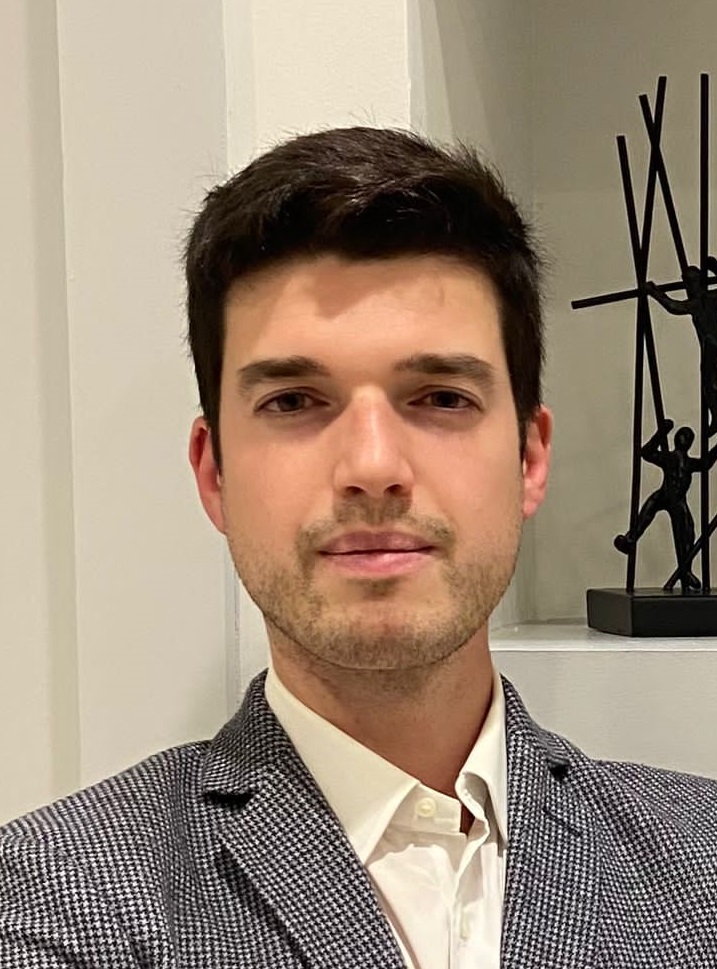

Administration
Department of Chemistry and Biochemistry
College of Science and Mathematics
Department of Chemistry and Biochemistry
Dr. Borgini graduated from the University of Siena, Italy, in 2015 and received his PhD in Chemical and Pharmaceutical Sciences under the supervision of Professor Maurizio Botta. During his PhD studies he worked on the synthesis of epigenetic modulators as anticancer agents, host protein inhibitors as antiviral compounds, and developed new antifungal drugs. He then pursued his Postdoctoral studies with Professor Peter Wipf at the University of Pittsburgh, USA. During that time, Dr. Borgini developed new ways to access fluorinated as well as 13C-labeled amino acids exploiting C-H functionalization, complex heterocyclic compounds by transition-metal catalyzed annulative cleavage of bicyclo[1.1.0]butane dihydroquinolines and dihydropyridines, and developed mitochondria-targeted PARP-1 inhibitor prodrugs as potential neuroprotective agents. Dr. Borgini started his independent career at Augusta University, USA, as Assistant Professor in Medicinal Chemistry at the Department of Chemistry and Biochemistry. The Drug Discovery campaigns in the Borgini Lab are aimed to find new ways to chemically modulate biological targets considered "difficult to drug", advancing new medicinal chemistry tools including Protein-Protein interaction Inhibitors and Covalent Inhibitors.
Development of Novel Covalent Inhibitors
Why Covalent Inhibitors? Covalent inhibitors have been known for over a century with more than 50 FDA-approved drugs for the treatment of cancer, infectious diseases, and CNS and cardiovascular disorders (Figure 1). Small molecule drugs that covalently bind irreversibly to their target proteins have several advantages over conventional reversible inhibitors. They include increased duration of action, less-frequent drug dosing, reduced pharmacokinetic sensitivity, and the potential to disrupt the activity of targets that were considered “undruggable”
Fear of toxicity caused by non-specific modifications of proteins, nucleic acids and other key biomolecules as well as conjugation with glutathione has, for a long time, restrained the development of covalent drugs. So, the question is: Why is there so much interest in developing covalent inhibitors nowadays ? Advancements in our synthetic organic chemistry and medicinal chemistry tools is leading to novel covalent warheads and to a deep understanding of their chemical reactivities within living organisms, (re)opening opportunities that couldn’t be achieved with classical small molecules inhibitors.
How does a covalent inhibitor work? Covalent inhibitors bind to their target in two steps, starting with equilibrium bond formation, and ending with covalent bond formation. The final state is considered to be irreversible, resulting in a drug–protein complex that is different from the one formed with a normal equilibrium bond. The drug-protein complex results from the reaction between the nucleophile of the protein (thiols for cysteine, hydroxy group for serine, threonine, and tyrosine, and amino group for lysine) and the electrophilic warhead.
What are we doing? Among all the covalent warheads used to generate covalent inhibitors, the acrylamide is the most frequently used in FDA-approved covalent inhibitors. Therefore, new acrylamide-type warheads are under development taking advantage of strain-release transformations. The novel warheads are highly versatile as a result of the tunability of their electronic properties, steric hindrance, and configuration of one or multiple stereocenters in close proximity to the reactive site. With this innovative design of covalent inhibitors, the warhead assumes a key-role in the substrate specificity, opening new opportunities for drug discovery and development campaigns.
Development of Selective Inhibitors of the Master Regulator of Anti-oxidative Responses Nrf2
Why Nrf2? Tumors are exposed to stress conditions such as nutrient deprivation, hypoxia, and acidic environments. To survive and proliferate, cancer cells activate defense mechanisms. One mechanism consists of the overactivation of transcription factor Nrf2, thus counteracting the effects of entire classes of anticancer agents in addition to radiotherapy and promoting drug resistance. Unfortunately, this phenomenon is frequently observed and often associated with a poor prognosis for the patient. Nrf2’s dual role is, however, not limited to cancer. Because of the wide range of genes affected by Nrf2, its activity showed both positive and negative effects in many diseases such as Alzheimer's disease, Parkinson’s disease, atherosclerosis, cardiac dysfunction, obesity, Insulin resistance syndrome, and viral infections.
What is Nrf2? Nrf2 is a transcription factor localized in the cytoplasm. Under physiological condition, Nrf2 undergoes to proteasomal degradation catalyzed by the KEAP1-mediated ubiquitination resulting in a short half-life. However, upon an oxidative insult, Nrf2 is internalized into the nucleus where interacts with ARE sequences and expressing thousands of anti-oxidative genes. Although the Nrf2-promoted anti-oxidative defense is crucial for the survival of cells and the maintaining of the organism’s homeostasis, its over-activation can lead to the insurgence and/or exacerbation of diseases.
What is the Challenge? Since the transient nature of transcription factors makes them challenging to target, no promising Nrf2 inhibitors are currently available for treatment. Moreover, the major drawback of known Nrf2 inhibitors is the lack of Nrf2 selectivity.
What is the potential outcome for the development of selective Nrf2 inhibitors? Selective Nrf2 inhibitors will elucidate biological down-stream pathways of this important transcription factor leading to new insight into the pathogenesis of diseases such as Alzheimer's disease and Parkinson’s disease. Moreover, thanks to the advent of novel technologies, new selective Nrf2 inhibitors can represent the first-in-class drugs for diseases which medical needs have not been met yet.